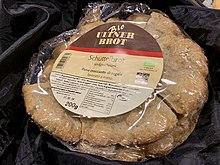Schüttelbrot
Schüttelbrot is a hard, crispy flatbread made from rye flour , water, yeast , salt and spices ( caraway , fennel seeds , anise , black clover or coriander ) with regionally different taste and appearance, which is particularly common in South Tyrol . It is characterized by its long shelf life and is traditionally eaten with bacon or cheese at Marende .
The dough of the Schüttelbrot is loosened by shaking it before baking and brought into the characteristic thin flat shape. This shape ensures that the bread hardens quickly after baking and can thus be stored for a long time without spoiling. Schüttelbrot was preferred in the huts dried and stored in Tyrol, where a management with fresh produce the Senner was too cumbersome.
The Schüttelbrot produced in Vinschgau is usually smaller, thinner and more brittle than the Eisack Valley Schüttelbrot, which, in contrast, is tougher, thicker and harder. The Schüttelbrot is related to the soft flatbreads known as Vinschgauer , but much thinner, crispier and longer lasting than these.
Spices
A characteristic of the bread of this region is the bread spice used: The bread clover ( Trigonella coerulea ) is an integral part of old Tyrolean cottage gardens; around 1610, the doctor Hippolyt Guarinoni names anise (Pimpinella Anisum L.) and fennel (Foeniculum vulgare) as the most common bread spices in Tyrol. Also coriander (Coriandrum sativum) and in adversity and wild cumin (Cuminum silvestre) were used to improve the taste of bread and as a digestive förderne agent.
history
Due to the harsh but relatively dry climate, the traffic difficulties and the seclusion of the rural high settlements, a special type of stock economy developed in South Tyrol in the early Middle Ages. This attached particular importance to the preservation techniques and led to independent developments in the field of smoked meat (bacon), souring (turnip tops), curing (meat) and drying (dried fruit, bread). As a self-sufficient provider, one endeavored to always have enough supplies in the house to be able to survive longer "dry spells" (winter) and, on the other hand, not to be burdened by the production of staple foods during labor-intensive times (harvest, etc.). The bread stocks and the shelf life of the bread played a key role. Most of the farms baked two to three times a year. The three basic forms of daily house bread in South Tyrol, the flat-like Schüttelbrot from the Eisack Valley region, the Vinschger Paarl made from two dough patties and the round but much larger Pusterer Breatl all have one thing in common: They are all suitable as hard bread or baked in advance The Schüttelbrot, unlike the other types of bread, comes out of the oven as dry bread.
Schüttelbrot is actually a preliminary stage of bread: In its production, it corresponds to the flatbread that was baked on hot stones in the time of the pile farmers. These cakes were previously called “reggl” or “regglproat” (from “riggln” = to shake, shake).
We first encounter them in a document in a Tyrolean baker's regulation that was written down in 1610, but refers to even older regulations. It says: “Then the pecks should bake the Kreizzerröggl well with rye“ häfl ”(sourdough) and wheat flour and without“ Grischen ”(bran) in the chraft Obermelter Tyrollian Lantsordnung”.
Today Schüttelbrot is also available in supermarkets.
Web links
Individual evidence
- ↑ Hermann Wopfner: The bread of the mountain farmers . In: Journal of the German Alpine Club , 1939, p. 122
- ^ Bread in southern Tyrol . Siegfried W. De Rachewiltz, Arunda 1980
- ↑ regglproat n. (Old) Schüttelbrot, flat bread / Villnöß. In: Tyrolean vocabulary on Eisack, Rienz and Etsch . Innsbruck 1972, p. 221
- ↑ Ignaz Zingerle, K. Theodor von Inama, Josef Egger: Die Tirolischen Weistümer . Vienna 1875–1891, Volume I, 26.

